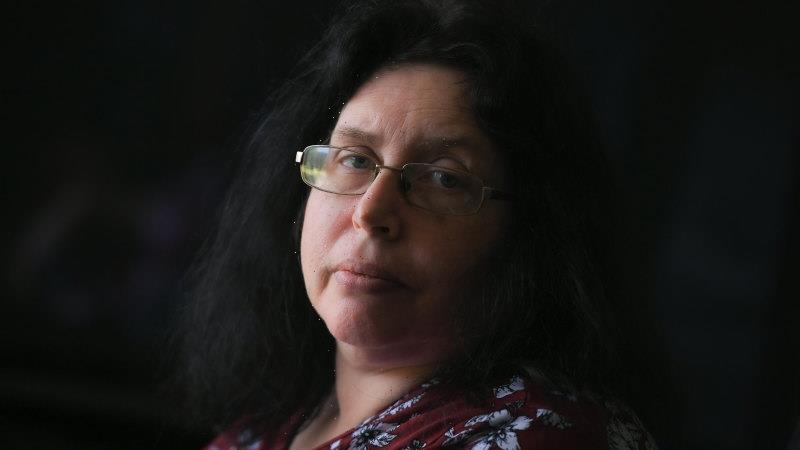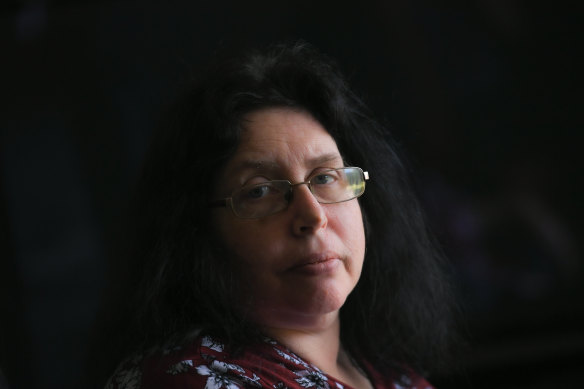Victorians with debilitating and painful chronic conditions are waiting for years to see specialist doctors as the state’s health system struggles under increased demand and worker shortages.
Data collated by the Victorian Agency for Health Information shows wait times for first specialist appointments in public hospital outpatient clinics continue to blow out in almost every area of medicine three years after the pandemic began.
Sarah Hindson has been waiting to see an ear, nose and throat specialist for eight years.Credit:Justin McManus
People needing appointments with ear, nose and throat surgeons face the most severe delays, with some waiting about three years before securing their first appointment with a specialist.
Deborah Amott, Victorian chair of the Australian Society of Otolaryngology Head and Neck Surgery, said the specialist wait times in Victoria were “mind-boggling”.
“We’re talking about one- or two-year-old children who can’t hear properly when they’re trying to acquire language,” the Melbourne ear, nose and throat surgeon said.
“This means that they have speech and language delay and the need for fairly intensive speech therapy to catch up with their peers.”
Amott said some teenagers unable to get into specialists were suffering up to seven or eight bouts of painful tonsillitis a year, while others experienced persistent sinus inflammation.
“When you think about what it would be like to have a cold for two years … the effect that would have on your energy levels, your productivity and sleeping – they’re very debilitating symptoms,” she said.
“It is, perhaps, not as dramatic as cancer, heart attacks or the like, but it can have a huge impact on people and their ability to participate fully either in school or in the workforce.”
She said wait times vary greatly between hospitals, but it was not unheard of for people to wait up to seven years to see an ear, nose and throat specialist.
Stephen Mason, chief executive of the Australian Patients Association, said regional Victorians often face the longest waits and a growing number of people are paying thousands of dollars in out-of-pocket costs to be treated in the private system to speed up their specialist appointments and elective surgery.
“Some people are dipping into their superannuation or taking out huge loans, which causes a lot of financial stress down the track,” he said.
Sarah Hindson had emergency surgery to remove her tonsils in 2014. Since then, the Bendigo woman has suffered from a postnasal drip, causing severe coughing fits that often lead to vomiting. She has been waiting to see a specialist for eight years.
Hindson was told in 2019 that she would be unlikely to secure an appointment in Bendigo due to a shortage of specialists, but she is unable to travel to Melbourne as she is a full-time carer for her husband.
Her symptoms deteriorated again recently and her GP wrote her a new referral in the hopes it will accelerate her case.
“After all these years, you almost give up and try and live with it,” Hindson said. “But some days it can be really distressing.”
Bendigo GP Katie Snow said the regional city had suffered from a shortage of ear, nose and throat specialists for years. She has been referring an increasing number of children to Melbourne’s Royal Children’s Hospital to see the specialists but said they are now being put on three-year-long wait lists for their first consultation.
“Parents are trying to find thousands of dollars to pay for their kids to get their tonsils out privately or kids are just being put on repeat courses of antibiotics, which is not good for them long term,” Snow said.
Snow estimates that pre-pandemic, the longest her paediatric patients would wait for non-urgent matters was between one and two years. Specialist consultations are recommended within 30 days for the most urgent patients and 365 days for the least urgent.
Amott said that while upper respiratory conditions went down during lockdowns, these viruses were now back with a vengeance, leading to a huge increase in referrals for ear, nose and throat specialists.
She added that the pandemic had exacerbated issues causing the delays, including staff shortages, but chronic under-resourcing of outpatient services had plagued the sector for years.
Meanwhile, Victorians needing to see a rheumatologist (musculoskeletal and autoimmune specialists) are waiting anywhere between three months and 695 days, and those requiring non-urgent neurosurgeon appointments can wait up to more than a year for a consultation.
Alberta Hoi, Australian Rheumatology Association treasurer, said there had been long wait lists to see rheumatologists in Victoria for a while, but the pandemic and GP shortages had resulted in some rheumatologists closing their books to new patients.
“Anecdotally, it’s not uncommon for patients to wait months or even years for an appointment,” the rheumatologist said.
”One of the biggest factors is the general lack of appreciation … for the growing needs of patients with chronic disease in the community. Rheumatology is a classic example of patients who need ongoing care and monitoring.“
General practitioner Yousuf Ahmad, who runs Inglis Medical Centre in Sale in Gippsland, said that pre-pandemic, his patients were waiting two to three months to see specialists, including ear, nose and throat surgeons, rheumatologists and dermatologists. Now, they are being told it will be at least a year.
“The wait is so long now, nobody can even give an estimated time, they just say you’ll be waiting more than a year,” Ahmad said.
A spokesman for the state Health Department said timely outpatient appointments are central to a patient’s long-term care needs and recovery.
“Even in the face of record demand and the challenges still being felt from the pandemic, the most urgent patients will always be prioritised,” he said.
“We continue to work closely with all health services to ensure maximum access and minimum disruption to their care.”
He said the state government’s $12 billion Pandemic Repair Plan was focused on training and recruiting healthcare staff and delivering more elective planned surgery, which will move patients through the health system faster.
The Morning Edition newsletter is our guide to the day’s most important and interesting stories, analysis and insights. Sign up here.
Most Viewed in National
From our partners
Source: Read Full Article






